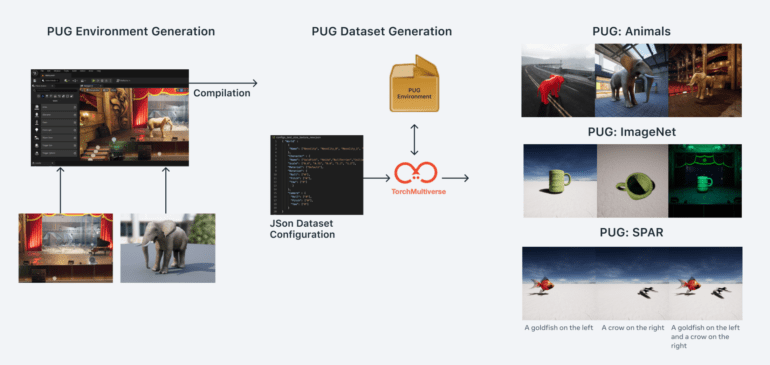TL;DR:
- PUG, a revolutionary AI research venture, presents synthetic Photorealistic Unreal Graphics datasets.
- Meta AI, Mila-Quebec AI Institute, and Université de Montréal collaboratively create PUG, leveraging Unreal Engine’s realism.
- PUG introduces TorchMultiverse Python package, enabling controlled dataset generation.
- Four datasets, including Animals, Robustness Test, Linguistic Vision, and Vision-Language Synergy, enhance the research scope.
- PUG sets a new standard for controlled artificial image data, impacting AI research, industries, and decision-making.
Main AI News:
The pursuit of developing transferrable and versatile data representations lies at the heart of advancements in machine learning. The significance of having access to vast pools of realistic, controllable data for training and assessment cannot be overstated, particularly when gauging the resilience and impartiality of deep neural network models. These attributes are indispensable for models deployed in practical scenarios, alongside their inherent precision. Nonetheless, the quest for such data is hindered by apprehensions about privacy, bias, and copyright violations. Most publicly accessible image repositories offer limited room for manipulation, yielding only basic image augmentations and deficient nuanced metadata.
Emerging as a solution is the utilization of synthetic imagery, where all parameters governing the generated scenarios are meticulously managed. This allows for the seamless extraction of comprehensive factor labels, offering insight into the capabilities of well-trained deep neural networks, including their robustness. Although holding immense potential, prevailing synthetic image datasets often fall short of providing an ideal platform for broader image representation research, primarily due to their lack of realism and limited scope.
In response, a collaboration between researchers from Meta AI (FAIR), Mila-Quebec AI Institute, and Université de Montréal has yielded a groundbreaking innovation: the Photorealistic Unreal Graphics (PUG) dataset. Tailored to cater to the representation learning community, this dataset boasts a level of realism that significantly surpasses existing publicly accessible resources. Leveraging the Unreal Engine [EpicGames], celebrated for its true-to-life visual fidelity and widely embraced in the gaming and entertainment sectors, the team has meticulously crafted environments that form the bedrock of these datasets. Additionally, the TorchMultiverse Python package has been introduced, granting a user-friendly Python interface that not only accommodates pre-rendered static image datasets but also facilitates the seamless generation of controlled datasets from any given PUG environment.
This achievement ushers in a new era by introducing four supplementary datasets that vividly exemplify the applicability of PUG across diverse domains of inquiry:
- Symbolic Space Exploration: The “Animals” dataset delves into symbolic space within the context of foundational model research and out-of-distribution (OOD) generalization.
- Robustness Testing: A comprehensive suite of factor alterations in ImageNet, encompassing aspects such as pose, backdrop, size, texture, and lighting, now serves as an additional robustness assessment benchmark.
- Linguistic Vision Evaluation: The “SPAR” dataset is designed to scrutinize linguistic vision models, effectively showcasing how synthetic data can surmount challenges present in prevailing benchmarks.
- Vision-Language Synergy: Unveiling “PUG: AR4T,” this benchmark stands as a testament to the prowess of fine-tuning vision-language models, effectively complementing the capabilities of PUG: SPAR.
In collective essence, the PUG datasets usher in a new era, establishing an unparalleled standard in the realm of controlled artificial image data, characterized by its exquisite control and photorealism. As AI research rapidly evolves, the invaluable contribution of PUG cannot be overstated, igniting transformative prospects for industries reliant on data-driven decision-making and cutting-edge model evaluation.
Conclusion:
The emergence of the Photorealistic Unreal Graphics (PUG) datasets marks a pivotal advancement in AI research. These meticulously crafted datasets, born from collaboration between leading institutions, transcend the boundaries of realism and control. The TorchMultiverse Python package further empowers researchers to navigate the dataset landscape with ease. As AI applications continue to shape industries, PUG’s influence reverberates not only in research but also in market competitiveness, offering invaluable insights and model evaluation for data-driven strategies. PUG’s introduction could potentially disrupt existing paradigms and redefine the landscape of AI-driven solutions.

